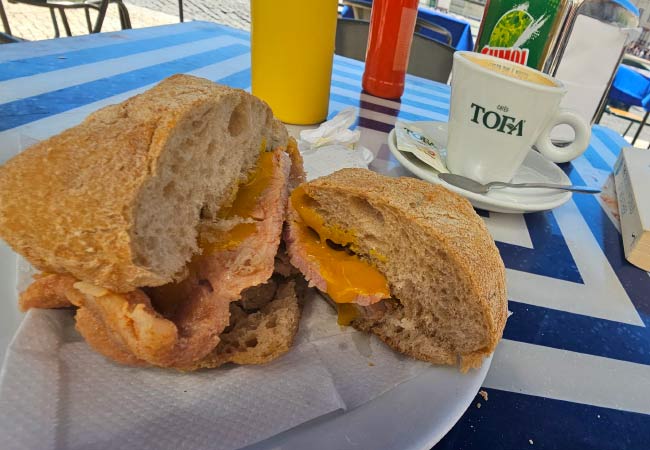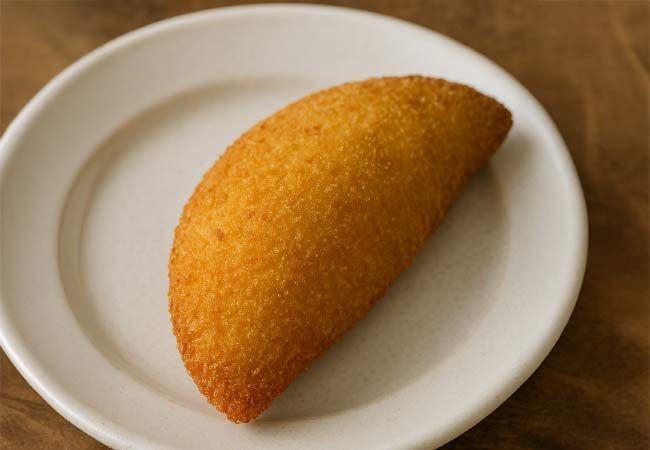LisbonLisboaPortugal.com
The best independent guide to Lisbon
LisbonLisboaPortugal.com
The best independent guide to Lisbon
Lisbon’s Best Savoury Snacks and Café Food
While the pastel de nata may be Lisbon's most famous pastry, the city's true daily fuel is found in its savoury snacks. In countless neighbourhood cafés, the local routine is built not around sugar, but around hearty pastries and simple, satisfying sandwiches that are enjoyed at all hours.
This is the world of salgados, Portugal's beloved fried pastries, with their golden shells and rich fillings of spiced shrimp, creamy codfish, or savoury meat. The city's snack culture extends far beyond these, defined by the iconic bifana, a perfect sandwich of garlic-marinated pork, and colonial-influenced treats like the triangular chamuça. These are not just snacks; they are a taste of the country's history.
For visitors, sampling these café staples offers a direct and authentic insight into the city's daily rhythms. This guide details Lisbon's essential savoury snacks, from the universally popular to the lesser-known local favourites, explaining what defines each one and the best way to enjoy them.
The essential Portuguese snacks every visitor must try
Bifana - Portugal's beloved pork sandwich
The bifana is arguably Portugal's most universal food, a simple pork sandwich valued by everyone from construction workers seeking a quick meal to office workers on their lunch break. It represents Portuguese culinary simplicity at its best: thin pork cutlets marinated in white wine, garlic, and paprika, then quickly fried and served in a crusty bread roll.
Visitors should be aware of a key regional difference. In Lisbon, the bifana is characteristically dry, allowing the flavour of the marinated pork to stand out, with yellow mustard offered on the side for you to add yourself. This contrasts with the saucier versions common in northern Portugal. Do not be misled by the name; while it may sound like ‘beef’, a true bifana is always made with pork.
Where to go: For a classic example, O Trevo in Praça Luís de Camões is a simple, standing-room-only establishment that is considered an institution. As Bifanas do Afonso is another hugely popular spot, known for the long queues that form for its specific recipe. To try a bifana in a more local, non-tourist setting, A Parreirinha do Chile is an authentic choice where the clientele is primarily Lisboetas.

Bifana
Pastel de Bacalhau
Of all the dishes made from salted cod, Portugal’s national ingredient, the pastel de bacalhau is perhaps the most famous. This simple, oval-shaped fritter is a cornerstone of the country's café culture, a staple snack found everywhere from humble neighbourhood counters to upscale restaurant menus.
The preparation combines shredded salt cod with mashed potato, finely chopped parsley, onion, and egg. This mixture is then shaped and deep-fried, creating a fritter that should have a crisp, golden exterior and a soft, savoury interior.
The quality of a pastel de bacalhau is determined by the ratio of fish to potato. A well-made fritter has a distinct and generous flavour of cod, while lesser versions are often bulked out with excessive potato. It is most commonly eaten as a quick snack, often standing at a counter, or as an appetiser to begin a larger meal.
Where to go: To try this snack in a traditional setting, O Licorista near Chiado is a classic standing-room-only bar popular with locals. For a more refined, sit-down version often served as a starter, the restaurant Gambrinus is known for preparing the fritter to a very high standard.

Rissol
The rissol is another essential savoury snack found in every Portuguese café. It is easily identified by its half-moon shape and a distinctive breaded crust that becomes golden and crisp when fried.
What sets the rissol apart from other fried pastries is its signature creamy interior, which is based on a béchamel sauce. The most classic filling is shrimp (rissol de camarão), a flavour deeply connected to the country’s coastline. Other common versions include minced meat (carne) and fish.
The contrast between the crunchy breaded exterior and the hot, savoury sauce of the filling is what makes the rissol so popular. A well-made version will be generously filled and fried so that the crust is crisp, not oily. It is a perfect example of a simple, comforting, and traditional Portuguese snack.
Where to go: For a typical neighbourhood experience, Padaria do Povo in Campo de Ourique is a traditional bakery where its shrimp rissóis are a local favourite. For a different atmosphere, the historic Pastelaria Versailles offers a more elegant setting to try this classic snack in its grand, mirrored dining room.

Prego
The prego is Portugal’s classic steak sandwich, the beef-based counterpart to the pork bifana. Its name comes from the Portuguese word for nail (prego), a reference to the slivers of garlic that are pounded into the thin steak before it is quickly seared on a hot griddle.
While the bifana relies on a marinade, the prego gets its assertive garlic flavour directly from the cooking process. The sandwich is most often served in a bread roll (prego no pão) and is frequently seasoned with mustard or spicy peri-peri sauce, the latter being a clear influence from Portugal’s historic ties to Mozambique.
The prego is widely regarded as a more substantial meal than a simple snack. It is a popular quick lunch, but it is also famously eaten as a final, savoury course after a large seafood dinner. For a full meal, it can also be ordered on a plate (prego no prato), typically accompanied by fries, rice, and a fried egg.
Croquette
The croquete, a staple of Portuguese cafés, has its origins in French cuisine but has been thoroughly adapted to local tastes. It is a small, cylindrical roll made from minced meat, typically beef or veal, bound in a thick sauce. The mixture is shaped, coated in breadcrumbs, and deep-fried.
What distinguishes the Portuguese croquete from its French predecessor is its robust seasoning. The flavour is savoury and assertive, not delicate. A well-made croquete should have a perfectly crisp, non-greasy crust that contrasts with the soft, dense meat filling inside.
This history reflects its journey from fine dining to an everyday staple. The croquete was first introduced to Portugal as a feature of aristocratic dining in the 19th century, but it has since become a common snack found in every neighbourhood café, typically eaten with a dab of yellow mustard.
Where to go: For a classic, high-quality example, the restaurant Gambrinus is famous for its refined recipe. The historic pastry shop Confeitaria Nacional, one of Lisbon’s oldest establishments, also serves a highly regarded and traditional version.
Folhado Misto
The folhado misto, often shortened to just misto, is a perfect example of Portuguese café practicality. It is a simple, rectangular puff pastry filled with slices of ham (fiambre) and cheese (queijo), making it a popular and convenient grab-and-go snack.
Unlike more complex salgados, the appeal of the folhado misto lies in its straightforward construction. The quality depends entirely on the flaky, buttery pastry and the simple combination of salty ham and melted cheese inside.
It should not be confused with a tosta mista, which is a standard grilled sandwich made with sliced bread; the folhado always uses puff pastry. While the classic version is just ham and cheese, a popular variation includes a thin slice of chorizo. Folhados are typically served warm, making them a common choice for a substantial morning snack.
Where to go: As a café staple, good folhados can be found throughout the city. For a classic experience, historic pastelarias like Pastelaria Versailles or Benard are reliable choices. The popular modern chain A Padaria Portuguesa also offers a consistently good version.

Empada
The empada is the Portuguese version of a small, savoury pie, easily identified by its distinctive dome shape and tender pastry. It represents a style of home cooking adapted for the café counter, offering a substantial yet conveniently sized snack.
The most traditional filling is shredded chicken (empada de galinha), slow-cooked in a rich, creamy sauce with onions and herbs. The pastry is also key; unlike a flaky folhado, the empada has a soft, shortcrust-style casing that is sturdy enough to contain the generous filling but remains tender.
While chicken is the classic, many establishments offer other varieties. Look for fillings such as veal (vitela), duck (pato), or sometimes seafood or vegetables. Empadas are typically sold and eaten at room temperature, making them a reliable and satisfying choice at any time of day.
Chamuça
The chamuça is the Portuguese version of the Indian samosa, a direct culinary link to the country's historical presence in Goa. These deep-fried, triangular pastries have become a true staple, their story further enriched by the influence of Mozambican culture in Lisbon.
While the shape is familiar, the fillings are adapted to Portuguese tastes. The most common varieties are filled with spiced minced beef or chicken, though vegetarian versions are also available. The spicing is generally milder and less complex than in traditional Indian samosas, creating a distinct fusion flavour.
Visitors to Lisbon can experience the different facets of its history. Cantinho do Aziz serves excellent Mozambican-style chamuças, while a specialist shop like A Chamuçaria offers a wide range of creative variations. For a taste closer to the Goan original, Indian restaurants such as Caxemira are an excellent choice.
Pão com Chouriço
Pão com Chouriço is one of Portugal’s simplest and most popular snacks, consisting of a smoky chorizo sausage baked inside a soft bread roll. It is a rustic and deeply satisfying food, valued for its straightforward preparation and rich flavour.
The method of cooking is key. Traditionally, the rolls are baked in a terracotta oven, which allows the paprika-infused fat from the sausage to melt and soak into the surrounding bread. This process gives the bread a distinct orange tint and a smoky, savoury taste.
It is particularly popular at festivals and as a late-night food. For a classic late-night experience, A Merendeira is an institution, serving fresh pão com chouriço from its ovens until the early hours of the morning. You will also frequently find stalls baking them fresh at weekend markets throughout the city.
Pastéis de Chaves
The Pastel de Chaves is a protected regional specialty from the city of Chaves in northern Portugal. This half-moon shaped pastry holds a Protected Geographical Indication (PGI) status, which strictly governs its recipe and origin, ensuring its quality and authenticity.
Its reputation is built on two key elements: an exceptionally thin and flaky puff pastry and a simple, savoury filling of minced veal. Unlike many other Portuguese snacks, the recipe is very precise, resulting in a delicate pastry that is prized for its unique texture and high-quality ingredients.
As a protected regional product, authentic Pastéis de Chaves are not as common as other café snacks. In Lisbon, they can only be found in a few licensed, specialist shops that are certified to sell the genuine article, offering a true taste of this famous northern delicacy.
The Royal Heritage: Confeitaria Nacional
Founded in 1829 by Balthazar Roiz Castanheiro, Confeitaria Nacional is not just a pastry shop but a living monument to Lisbon's history. Its enduring prestige was cemented in 1873 when it was appointed the official supplier to the Portuguese Royal House, a distinguished role it continues in a modern context as a supplier to the Portuguese Presidency. This long-standing reputation for excellence is built on nearly two centuries of classic pastry and confectionery technique.
While known for a wide range of traditional pastries, the Confeitaria’s most significant contribution to the national cuisine is the Bolo-Rei (King Cake). Balthazar Castanheiro is credited with introducing this fruit- and nut-studded festive bread to Portugal from the south of France in the 19th century. It has since become the country's most essential Christmas and Epiphany tradition, with the Confeitaria's version still regarded as the benchmark.
The ground floor retains its original 19th-century elegance, with mirrored ceilings, gold-leaf detailing, and long counters of dark wood and marble. This is the busiest part of the café, where customers stand for a quick coffee and choose from an extensive display of both intricate sweet pastries (pastelaria fina) and savoury snacks (salgados), including their highly regarded croquetes. The atmosphere is a direct link to the era when the café was a pioneer, introducing Lisbon to innovations like gas lighting.
For a more relaxed experience, the upstairs dining room, the Salão de Chá (Tea Room), offers a quieter, more formal setting with table service. It provides a distinct atmosphere from the busy counter below, allowing visitors to experience a more refined and traditional side of Lisbon’s café society while enjoying views over the bustling Praça da Figueira. Sources
Coffee and Salgados: Perfect Partnerships
In Portugal, the daily coffee break is an institution. These short pauses, taken mid-morning and again in the afternoon, are a fundamental part of the workday and social life. It is during these moments that the classic partnership between strong, dark coffee and a savoury salgado is most evident.
The pairing works as a classic contrast of flavours. The salty, often rich nature of a salgado provides the ideal counterpoint to the bitter intensity of a classic Portuguese espresso, known as a bica. For those who prefer milk, the snacks work just as well with a pingado (an espresso with a splash of milk), a meia de leite (half coffee, half milk), or a galão, which is served in a tall glass with more milk.
Historical roots running deep
Lisbon’s café culture dates to the late 18th century, when the city’s first public coffee houses opened. These establishments quickly evolved into essential social spaces, becoming the preferred gathering points for the city’s writers, artists, and politicians. Some of these historic cafés, such as Martinho da Arcada (founded in 1782) in the Praça do Comércio, remain in operation today.
The flavours found in many salgados are a direct result of Portugal’s maritime history. Ingredients sourced from across the globe were integrated into the national diet, a prime example being the extensive use of fresh coriander, a practice unique in Europe. This fusion is perfectly demonstrated by the chamuça, a snack adapted from the Indian samosa via contact in Goa, which has become a thoroughly Portuguese staple.
Many traditional sweets originated in convents and monasteries, where nuns used egg whites for starching religious habits, leaving abundant yolks for confectionery. The 1834 abolition of religious orders led to recipes being sold commercially, democratizing formerly monastic treats.
How to Order: A Guide to the Lisbon Café
The heart of any Portuguese café is the balcão, or counter. While table service is available, the true local experience is to find a space at the counter for a quick coffee and a snack. It is faster, more efficient, and often slightly cheaper.
The process is simple. Find a spot, catch the eye of the person behind the counter, and give your order. There is no need to pay immediately. Enjoy your food and drink right there at the counter, and when you are finished, go to the cashier (often at one end of the counter), state what you had (um café e um rissol, for example), and pay.
Tipping for counter service is not expected. If you prefer a more leisurely pace, you can opt for table service (serviço de mesa). Simply take a seat and a waiter will come to you. Be aware that the prices for table service are typically a little higher than at the counter.
Discover more of Lisbon with our most popular guides
If you've found our content valuable, we'd welcome your support.
The digital publishing landscape has evolved significantly. As a small independent publisher, we face growing challenges. Search engines increasingly favour paid content over organic results, while AI-generated content often reproduces original work without attribution.
To support our work, please consider bookmarking this page (press Ctrl + D) for quick access. If you find an article helpful, we'd be grateful if you'd share it with friends on social media.
For specific questions, please see our Reddit community at r/LisbonPortugalTravel.
Should you notice any outdated or incorrect information, please contact us at [email protected]
Thank you for helping us continue to provide valuable content in an increasingly challenging digital environment.
A complete list of all of our Lisbon articles
If you've found our content valuable, we'd welcome your support.
The digital publishing landscape has evolved significantly. As a small independent publisher, we face growing challenges. Search engines increasingly favour paid content over organic results, while AI-generated content often reproduces original work without attribution.
To support our work, please consider bookmarking this page (press Ctrl + D) for quick access. If you find an article helpful, we'd be grateful if you'd share it with friends on social media.
For specific questions, please see our Reddit community at r/LisbonPortugalTravel.
Should you notice any outdated or incorrect information, please contact us at [email protected]
Thank you for helping us continue to provide valuable content in an increasingly challenging digital environment.

































